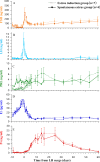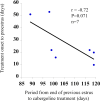Changes in luteinizing hormone pulse frequency and prolactin levels in bitches in response to estrus induction by cabergoline-its cases where it is delayed to induce estrus
- PMID: 33132356
- PMCID: PMC7804036
- DOI: 10.1292/jvms.19-0397
Changes in luteinizing hormone pulse frequency and prolactin levels in bitches in response to estrus induction by cabergoline-its cases where it is delayed to induce estrus
Abstract
The effect of estrus induction by cabergoline on gonadotropin and steroid hormone responses was examined in anestrous bitches. Eleven beagles were used in the study; seven were included in the estrus induction group and four were included in the spontaneous estrus group. Cabergoline was orally administered to the estrus induction group at 5 µg/kg once daily for four weeks, or until hemorrhagic discharge was detected. The inter-estrus interval in the estrus induction group was significantly shorter than the previous estrus interval. Bitches that showed proestrus within four weeks of treatment showed increased luteinizing hormone (LH) pulse frequency and, subsequently, increased estradiol (E2) levels. Prolactin (PRL) levels declined promptly after treatment, except in one bitch that did not show proestrus during the cabergoline treatment period. There was a significant correlation between the time to proestrus induction and the reduction in PRL levels. A positive correlation was found between the LH levels two weeks after cabergoline administration and PRL reduction. This study demonstrates that an abrupt reduction in PRL is likely to be important for initiation of estrus in bitches. A reduction in PRL indirectly leads to an increase in LH pulse frequency, which regulates follicular development in bitches. However, if the period from the end of the previous estrus to the cabergoline treatment is short, it may take some time to show proestrus without increasing E2 levels, even if the LH level increases after cabergoline administration.
Keywords: bitch; cabergoline; estrus induction; luteinizing hormone pulse; prolactin.
Conflict of interest statement
The authors have nothing to disclose.
Figures



Similar articles
-
Follicular development and plasma concentrations of LH and prolactin in anestrous female dogs treated with the dopamine agonist cabergoline.Theriogenology. 2007 Oct 1;68(6):826-33. doi: 10.1016/j.theriogenology.2007.06.007. Epub 2007 Aug 8. Theriogenology. 2007. PMID: 17689603 Clinical Trial.
-
Effect of stage of anestrus on the induction of estrus by the dopamine agonist cabergoline in dogs.Theriogenology. 1999 Feb;51(3):597-611. doi: 10.1016/s0093-691x(99)00013-8. Theriogenology. 1999. PMID: 10729045
-
Selective control of the estrous cycle of the dog through suppression of estrus and reduction of the length of anestrus.Theriogenology. 2003 Mar;59(5-6):1441-8. doi: 10.1016/s0093-691x(02)01183-4. Theriogenology. 2003. PMID: 12527090
-
Concentrations of reproductive hormones in canine serum throughout late anestrus, proestrus and estrus.Biol Reprod. 1982 Dec;27(5):1196-206. doi: 10.1095/biolreprod27.5.1196. Biol Reprod. 1982. PMID: 6819009
-
Induction and synchronization of estrus in dogs.Theriogenology. 2005 Aug;64(3):766-75. doi: 10.1016/j.theriogenology.2005.05.025. Theriogenology. 2005. PMID: 15993937 Review.
Cited by
-
The Effect of Prolactin on Gene Expression and the Secretion of Reproductive Hormones in Ewes during the Estrus Cycle.Animals (Basel). 2024 Jun 25;14(13):1873. doi: 10.3390/ani14131873. Animals (Basel). 2024. PMID: 38997985 Free PMC article.
References
-
- Araujo-Lopes R., Crampton J. R., Aquino N. S., Miranda R. M., Kokay I. C., Reis A. M., Franci C. R., Grattan D. R., Szawka R. E.2014. Prolactin regulates kisspeptin neurons in the arcuate nucleus to suppress LH secretion in female rats. Endocrinology 155: 1010–1020. doi: 10.1210/en.2013-1889 - DOI - PubMed
-
- Arnold S., Arnold P., Concannon P. W., Weilenmann R., Hubler M., Casal M., Döbeli, Fairburn A., Eggenberger E., Rüsch P.1989. Effect of duration of PMSG treatment on induction of oestrus, pregnancy rates and the complications of hyper-oestrogenism in dogs. J. Reprod. Fertil. Suppl. 39: 115–122. - PubMed

